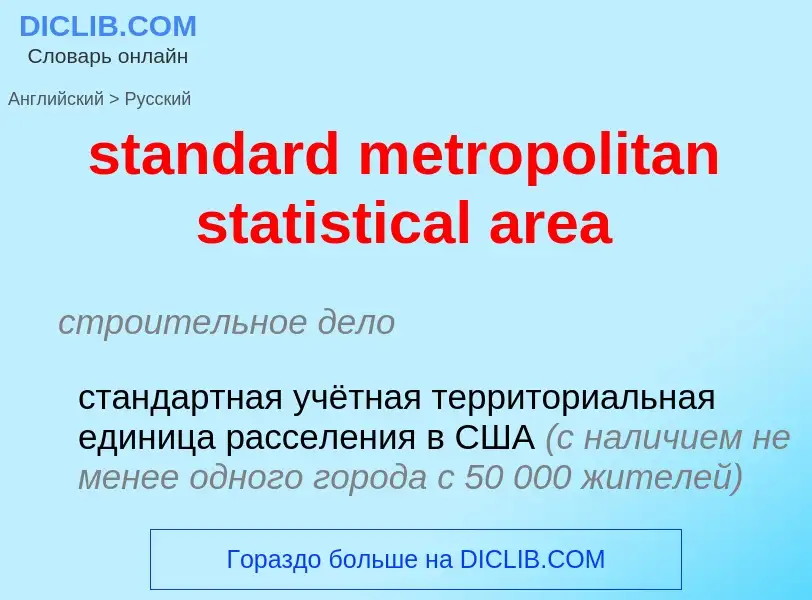Перевод и анализ слов искусственным интеллектом ChatGPT
На этой странице Вы можете получить подробный анализ слова или словосочетания, произведенный с помощью лучшей на сегодняшний день технологии искусственного интеллекта:
- как употребляется слово
- частота употребления
- используется оно чаще в устной или письменной речи
- варианты перевода слова
- примеры употребления (несколько фраз с переводом)
- этимология
standard metropolitan statistical area - перевод на русский
строительное дело
стандартная учётная территориальная единица расселения в США (с наличием не менее одного города с 50 000 жителей)
['kænzəs'siti]
география
г. Канзас-Сити
существительное
общая лексика
г. Канзас-Сити
[teksɑ:'kænə]
существительное
география
г. Тексаркана
общая лексика
большой город с пригородами
столичный район
общая лексика
городская агломерация
общая лексика
большой город с пригородами
столичный район
строительное дело
город с пригородами (связанные общей экономической и социальной жизнью)
Определение
Википедия
 of the United States and Puerto Rico, Mar 2020.png?width=120)
In the United States, a metropolitan statistical area (MSA) is a geographical region with a relatively high population density at its core and close economic ties throughout the area. Such regions are neither legally incorporated as a city or town would be, nor are they legal administrative divisions like counties or separate entities such as states; because of this, the precise definition of any given metropolitan area can vary with the source. The statistical criteria for a standard metropolitan area were defined in 1949 and redefined as metropolitan statistical area in 1983.
A typical metropolitan area is centered on a single large city that wields substantial influence over the region (e.g., New York City or Chicago). However, some metropolitan areas contain more than one large city with no single municipality holding a substantially dominant position (e.g., Dallas–Fort Worth metroplex, Virginia Beach–Norfolk–Newport News (Hampton Roads), Riverside–San Bernardino (Inland Empire) or Minneapolis–Saint Paul (Twin Cities)). MSAs are defined by the U.S. Office of Management and Budget (OMB) and used by the Census Bureau and other federal government agencies for statistical purposes.

 of the United States and Puerto Rico, Mar 2020.png?width=200)









![Kansas]] River approaching from the southwest. Downtown Kansas City, Missouri, is immediately southeast of their confluence and [[North Kansas City, Missouri]], is to its northeast. Kansas]] River approaching from the southwest. Downtown Kansas City, Missouri, is immediately southeast of their confluence and [[North Kansas City, Missouri]], is to its northeast.](https://commons.wikimedia.org/wiki/Special:FilePath/Kansas City satellite map.jpg?width=200)







![[[Four States Auto Museum]] in downtown Texarkana [[Four States Auto Museum]] in downtown Texarkana](https://commons.wikimedia.org/wiki/Special:FilePath/Four States Auto Museum April 2016 34.jpg?width=200)

![A metropolitan area usually includes a main city and a series of smaller satellite cities as can be seen in this map of [[Madrid]]'s metropolitan area (click on the map to enlarge it). A metropolitan area usually includes a main city and a series of smaller satellite cities as can be seen in this map of [[Madrid]]'s metropolitan area (click on the map to enlarge it).](https://commons.wikimedia.org/wiki/Special:FilePath/Hoja-especial-50-Madrid y su entorno-2012.jpg?width=200)
![The [[Melbourne]] metropolitan area in [[Australia]] seen at night from the [[International Space Station]] The [[Melbourne]] metropolitan area in [[Australia]] seen at night from the [[International Space Station]]](https://commons.wikimedia.org/wiki/Special:FilePath/Melbourne at night from the International Space Station.jpg?width=200)
